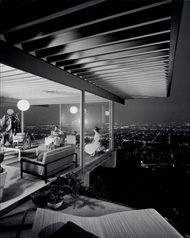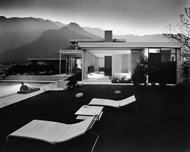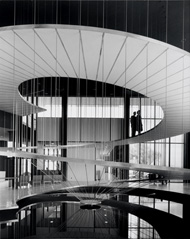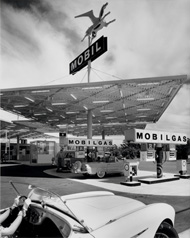 |

 |
 |
Case Study House #22, Los Angeles, 1960
Pierre Koenig, Architect
|
 |
 |
|
This exhibition honors the 95th birthday and life's work of architectural photographer Julius Shulman. For 70 years, Shulman steadily created one of the most comprehensive visual chronologies of modern architecture and the development of the Los Angeles region. The prints in the exhibition are selected from a portfolio of more than 70,000 images.
Julius Shulman is renowned for some of the most iconic photographs in architectural history. His images seem to reveal the essence of an architect's vision and capture the spirit of the eras in which they were produced. Under the experimental Case Study House Program, architects were commissioned to design innovative single-family homes in California. Shulman photographed the majority of the Case Study projects, such as the one above, free of charge.
|
 |

 |
 |
Kaufmann House, Palm Springs, 1947
Richard Neutra, Architect
|
 |
 |
Julius Shulman's photographs of Southern California's inventive modern homes promoted the careers of numerous visionary architects including Richard Neutra, John Lautner, and Pierre Koenig. Mid-20th-century homes come alive through Shulman's compositions of carefully posed models set against streamlined furnishings and breathtaking vistas.
Shulman's widely published images marketed the West Coast's casual residential elegance to the world. Decades after the initial prints were created, Shulman's scenes continue to herald the beauty and livability of modern architecture and the glamour of the California dream.
|
 |
 |

 |
 |
Convair Astronautics, San Diego, CA, 1958
Pereira & Luckman, Architects
|
 |
Julius Shulman's intuitive timing and distinctive camera angles produced bold portraits of hundreds of modern structures beyond Los Angeles. Through Shulman's lens, buildings become unique studies of mass, shadow, and light. In this image, Shulman's perspective captures the dynamic lines of a suspended spiral ramp in San Diego.
|
 |
|
Julius Shulman's attentive professionalism was as critical to his success as his pioneering principles of design. His impeccably organized working archive of 260,000 prints, negatives, and color transparencies enabled him to fulfill the requests of generations of clients in architecture, construction, academia, publishing, and the media. Rather than guard his efficient business methods and photographic techniques, Shulman shares his acquired knowledge in his book The Photography of Architecture and Design: Photographing Buildings, Interiors, and the Visual Arts (1977).
Shulman enhanced the text with revealing photographs of the tools of his trade. Displayed collectively, these images render a self-portrait of the photographer as a proud entrepreneur dedicated to the development of his craft, the promotion of his product, and the perpetuation of his legacy.
|
 |
 |

 |
 |
Mobil Gas Station, Anaheim, CA, 1956
Smith & Williams, Architects
|
 |
While global demands for his talent allowed Shulman to travel extensively, Los Angeles has always been his home. The thousands of photographs he has taken of the city now serve as significant visual records of the unique urban fabric of Los Angeles. Poetic images of subjects not normally associated with Shulman, such as streetscapes, movie palaces, factories, and bustling markets, highlight the energy and style of a metropolis that continues to define itself.
This exhibition is located at the Getty Center, Research Institute Exhibition Gallery.
|
 |